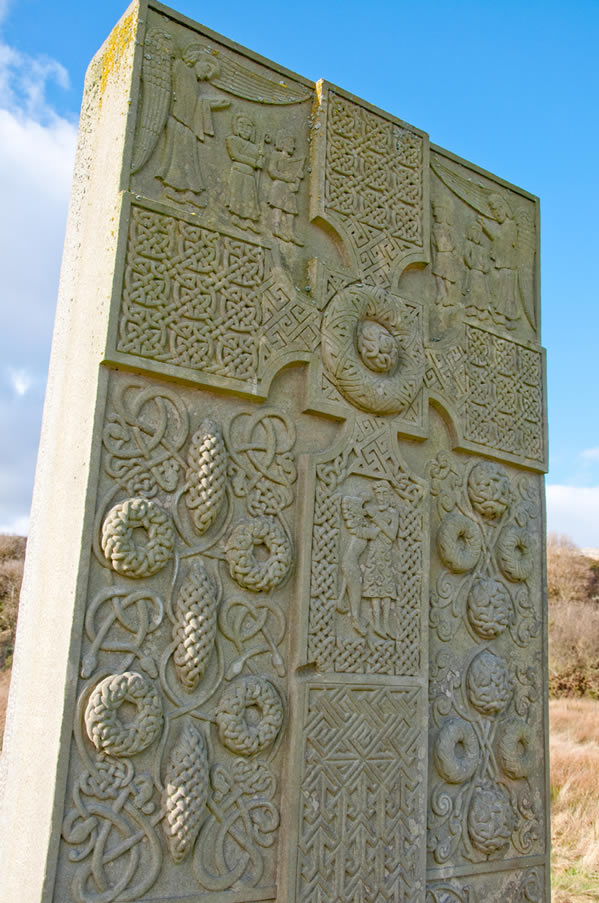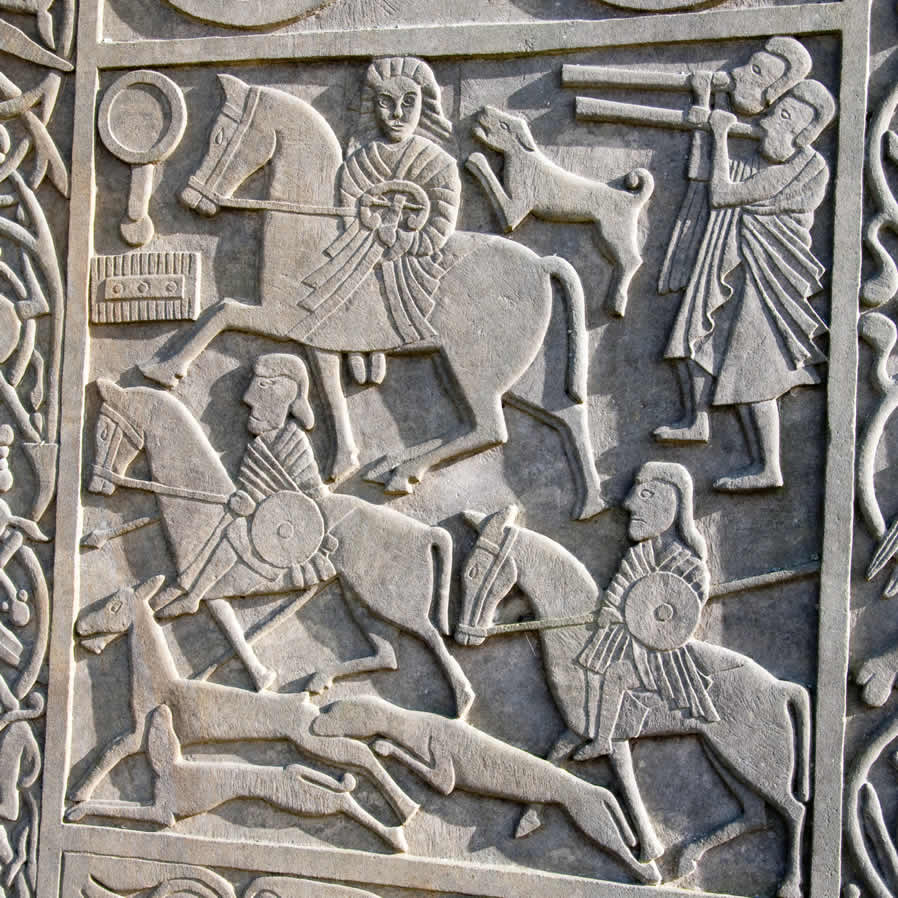8.2 Hilton of Cadboll
Tarbat Ness is home to a number of standing stones which reflect the artistic skill and Christian faith of the Pictish people who carved them. The stones may have marked the boundary of the lands controlled by the monastery at Portmahomack.
The cross-slab at Hilton of Cadboll is a replica of the stone which originally stood here. It was carved in 2000. The land-facing back of the stone is a copy of the original stone which is now in the Museum of Scotland. However, the sea-facing front side was defaced in the 17th century so the replica is mostly based on Pictish designs.
The lower portion of the stone was re-discovered in 2001 and is now preserved in the Seaboard Memorial Hall in nearby Ballintore.
There are three standing stones on the east coast of Tarbat Ness – here at Hilton of Cadboll, in the adjoining village of Shandwick and further south at Nigg.
Artist, Barry Grove, created a design for this side of the stone based on the surviving fragment and typical Pictish designs and symbols.
The original stone once stood outside St Mary’s Chapel, a short distance from the sea. The chapel remains are now only visible as grass-covered mounds. The stone was broken a number of times. In 1676 the upper part of the front was defaced and re-used as a gravestone. The carvings were replaced with an inscription commemorating Alexander Duff and his three wives.

The central panel of the stone shows a hunting scene. A woman wearing an ornate broach rides on horseback. She is accompanied by two other riders and two people on foot playing trumpet. Three dogs are bounding beside them.

To the left of the woman are a comb and mirror symbol. Other typical Pictish symbols appear above – a crescent and v-rod, and at the top, a double disc and z-rod.
The lower part of the Hilton of Cadboll stone was lost and only rediscovered in 2001. Having been buried underground for so long, the details of the stone carving have not weathered or worn away.
The base is now in the local Seaboard Memorial Hall. Check the website for opening hours.
Tarbat Ness
- 8.1 Tarbat Discovery Centre, Portmahomack
Between 1994 and 2007 archaeologists excavated an area around the church of St Colman at Portmahomack on the tip of Tarbat Ness. They discovered an extensive monastic settlement dating from the late 6th century. The Tarbat Discovery Centre tells the story of this Christian settlement and its re-discovery by archaeologists....
- 8.2 Hilton of Cadboll
Tarbat Ness is home to a number of standing stones which reflect the artistic skill and Christian faith of the Pictish people who carved them. The stones may have marked the boundary of the lands controlled by the monastery at Portmahomack. The cross-slab at Hilton of Cadboll is a replica...
- 8.3 Shandwick
The cross-slab stone at Shandwick is covered with Christian symbols. This is an expression of Pictish Christianity rather than being a stone which combines pagan and religious designs. There were probably a number of monastic settlements along this coast under control of the large monastery at nearby Portmahomack. The stone...
- 8.4 Nigg Stone
The Nigg Stone is one the finest carved Pictish stones. It was carved around 800AD - or perhaps earlier - and is covered in Christian symbols From the details of this carved stone, it is clear that there were close links between monks living in Nigg and Portmahomack, and the...
- 8.5 Craig Phadraig
Craig Phadraig is a wooded hill on the edge of Inverness. Follow the path up the hill to discover the possible remains of King Brude’s fort. Colmcille’s biographer Adomnán describes the saint visiting King Brude, the Pictish king, at his fort somewhere near the River Ness - possibly here at...
- 8.6 Other Pictish Stone Sites North of Inverness
Other Pictish stone sites Explore the history of the Picts along the east coast from Inverness northwards. The Highland Pictish Trail Trail highlighting 17 sites with Pictish stones, ranging from Inverness to Dunrobin near Golspie. A Catalogue of Pictish Stones at Inverness Museum and Art Gallery The catalogue lists all...










Bòrd na Gàidhlig
Great Glen House
Leachkin Road
Inverness
Scotland, IV3 8NW
(+44) 01463 225454
colmcille@gaidhlig.scot
Colmcille
Foras na Gaeilge, 2-6 Queen Street
Belfast
Northern Ireland
BT1 6ED
(+44) 028 9089 0970
colmcille@forasnagaeilge.ie
Colmcille
Foras na Gaeilge, An Chrannóg
Na Doirí Beaga
Gaoth Dobhair
Donegal, Ireland. F92 EYT3
(+353) 074 9560113
colmcille@forasnagaeilge.ie


